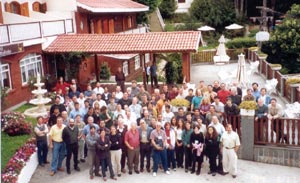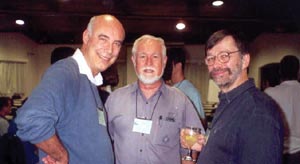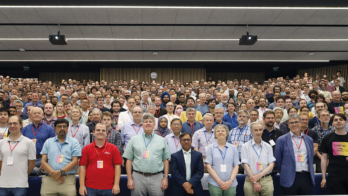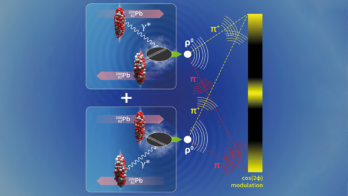For nearly two decades nuclear and particle physicists have been searching for experimental evidence of a new state of deconfined hot quark-gluon matter. A recent study institute in Brazil took stock of their progress so far.

The search for a phase transformation between hadronic matter and a state of deconfined colour charge, generically known as quark-gluon plasma (QGP), began in the mid-1980s with experiments at CERN’s Super Proton Synchrotron (SPS) in Europe, and Brookhaven’s Alternating Gradient Synchrotron in the US. In 2000, the search moved onto the Relativistic Heavy Ion Collider (RHIC) at Brookhaven. A deconfined quark phase is predicted by numerical solutions of quantum chromodynamics (QCD) at finite temperature, and so its identification would be a dramatic manifestation of the theory that governs strong interactions.
The idea of organizing a Pan American advanced study institute (PASI) under the auspices of the US National Science Foundation’s Americas programme was first advanced in early 2000. A number of heavy-ion researchers recognized that such an institute could help emerging research groups in Latin America, and would serve as a focus for potential new participants from widely scattered and distant locations in the region. Planned as an advanced school rather than a conference or workshop, the objective of the institute was primarily pedagogical, although the presentation of the most recent results in both theory and experiment was also on the agenda. Of equal importance, however, was PASI’s role as a meeting place where participants could forge new working relationships, and the selection of the small Brazilian mountain resort of Campos do Jordão as the venue was made with this in mind.
The participation reflected a good regional balance, with 20 US and European physicists, and 28 Latin Americans. There were 5 US/European and 16 Latin American postdocs, and 23 US/European and 36 Latin American students. The primary lecturers delivered hot-off-the-press scientific material on all aspects relevant to heavy-ion research, including the theory of strong interactions and experimental heavy-ion collision results. Lectures ranged from elementary tutorial-style introductions to technical seminars at the forefront of the subject. The study of the properties of QGP and the confining vacuum structure was at the heart of the meeting. Daily discussion sessions allowed the principal lecturers and the participants to interact. One afternoon was devoted to a survey of research activities in Latin America. The school was supported by the US National Science Foundation and Department of Energy, Brazilian federal and state agencies (CNPq, FAPERJ, FAPESP, the Federal University of Rio de Janeiro and the University of Sao Paulo), and by Germany’s GSI laboratory.
Broad programme

Wit Busza of MIT presented a general introduction course to the physics of heavy-ion collisions. His lectures were complemented by several brilliant tutorials on the foundations of this interdisciplinary field. These were given by Guido Altarelli of CERN on QCD, Takeshi Kodama of Rio de Janeiro on relativistic gases, Berndt Muller of Duke University on the properties of quark matter, Johann Rafelski of Arizona on hadrochemistry, and Columbia’s Bill Zajc on the correlation observables such as Hanbury-Brown and Twiss (HBT) intensity interferometry.
The experimental programmes were thoroughly covered in several courses. John Harris of Yale and Bill Zajc gave a survey of the RHIC physics programme and surveyed the latest results from the Brookhaven collider’s STAR and PHENIX experiments. Christof Roland of MIT presented the latest work of another RHIC experiment, PHOBOS. CERN’s SPS experimental programme was reported by Federico Antinori of Padova, while Karel Safarik of CERN took the students into the instrumental realm of particle tracking in a detailed and fascinating lecture. In his presentation, Seattle’s Tom Trainor clearly showed the complexity of some experimental results.
The study of vacuum structure, confinement, lattice gauge theories and quantum transport was addressed by Dima Kharzeev of Brookhaven, Adriano Di Giacomo of Pisa, Frithjof Karsch of Bielefeld, and Hans-Thomas Elze of Rio de Janeiro. Bira van Kolck of Arizona and Brookhaven introduced the power of effective theories in the study of strong interactions, while Jörg Aichelin of Nantes showed how this method can be used in the study of phase transition dynamics.
These hard-core theoretical topics were accompanied by more gentle phenomenological courses by Bob Thews of Arizona on charm, Klaus Werner of Nantes on event generators, and Laszlo Csernai of Bergen on hydrodynamics and flow. Frankfurt’s Horst Stöckers’ survey of QGP signals relied on exotica such as stable black hole formation in heavy-ion collisions, quite in contrast to the more traditional discussion of strangeness and entropy evidence for the formation of deconfined states, offered by Arizona’s Johann Rafelski.
Among more than 15 seminars and lectures reporting the latest progress were many notable theoretical and experimental contributions. Frederique Grassi of Sao Paulo introduced open issues in particle emission, US PASI student Paul Sorensen from UCLA surveyed azimuthal anisotropy in strange particle production, and Latin American PASI student Javier Castillo discussed multistrange particle production at RHIC.
Constantino Tsallis of Rio de Janeiro gave the institute’s final lecture on non-extensive statistics and its applications, leading to a discussion which carried on well into dinner. Rainy weather hampered the programme of excursions to the local countryside, but ensured that the lecture rooms were always full of enthusiastic students, which was both stimulating for the lecturers and very promising for the future of the field.
Further reading
H T Elze, E Ferreira, T Kodama, J Rafelski and R L Thews (eds) (in press) New States of Matter in Hadronic Interactions (AIP New York, October 2002).





